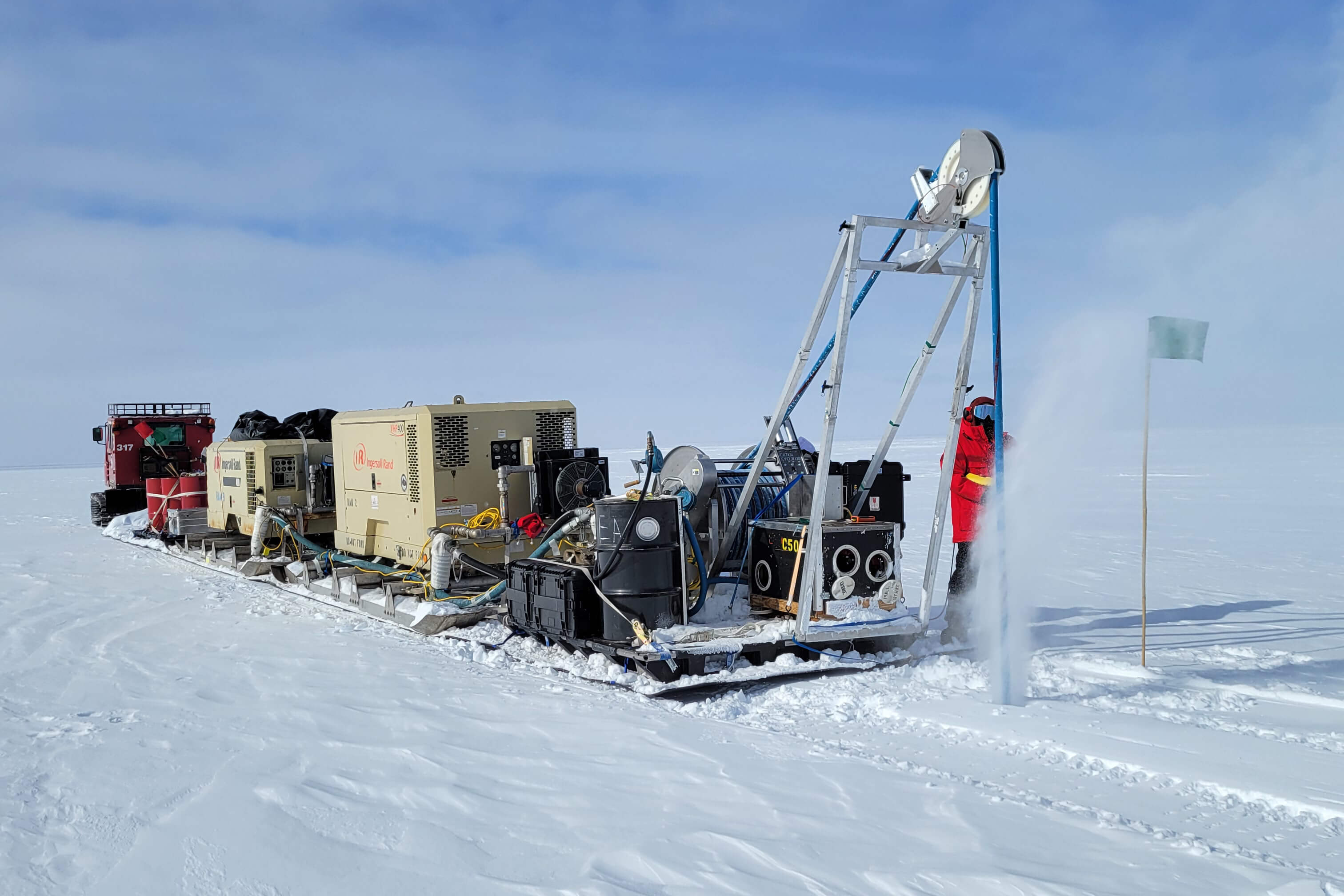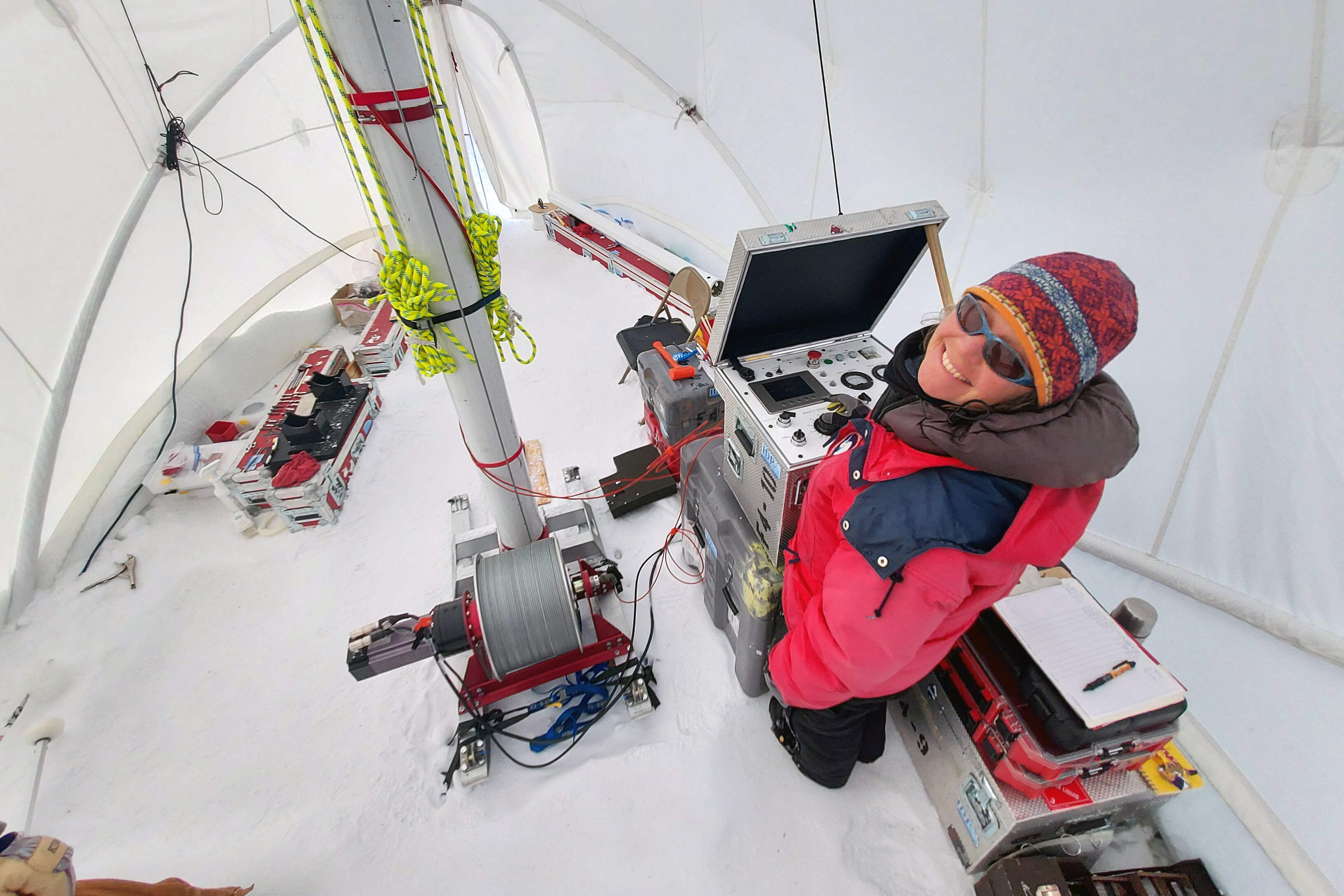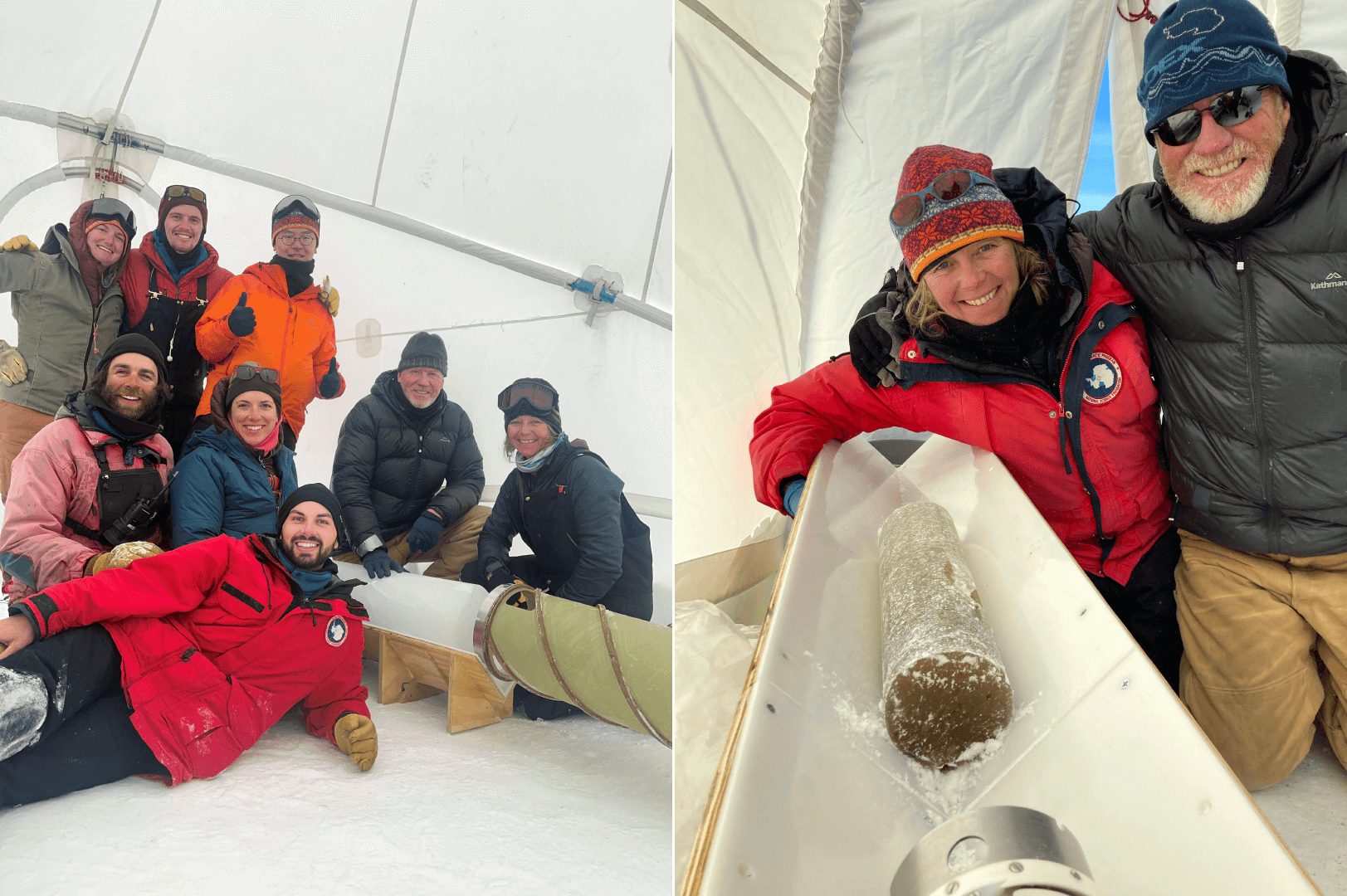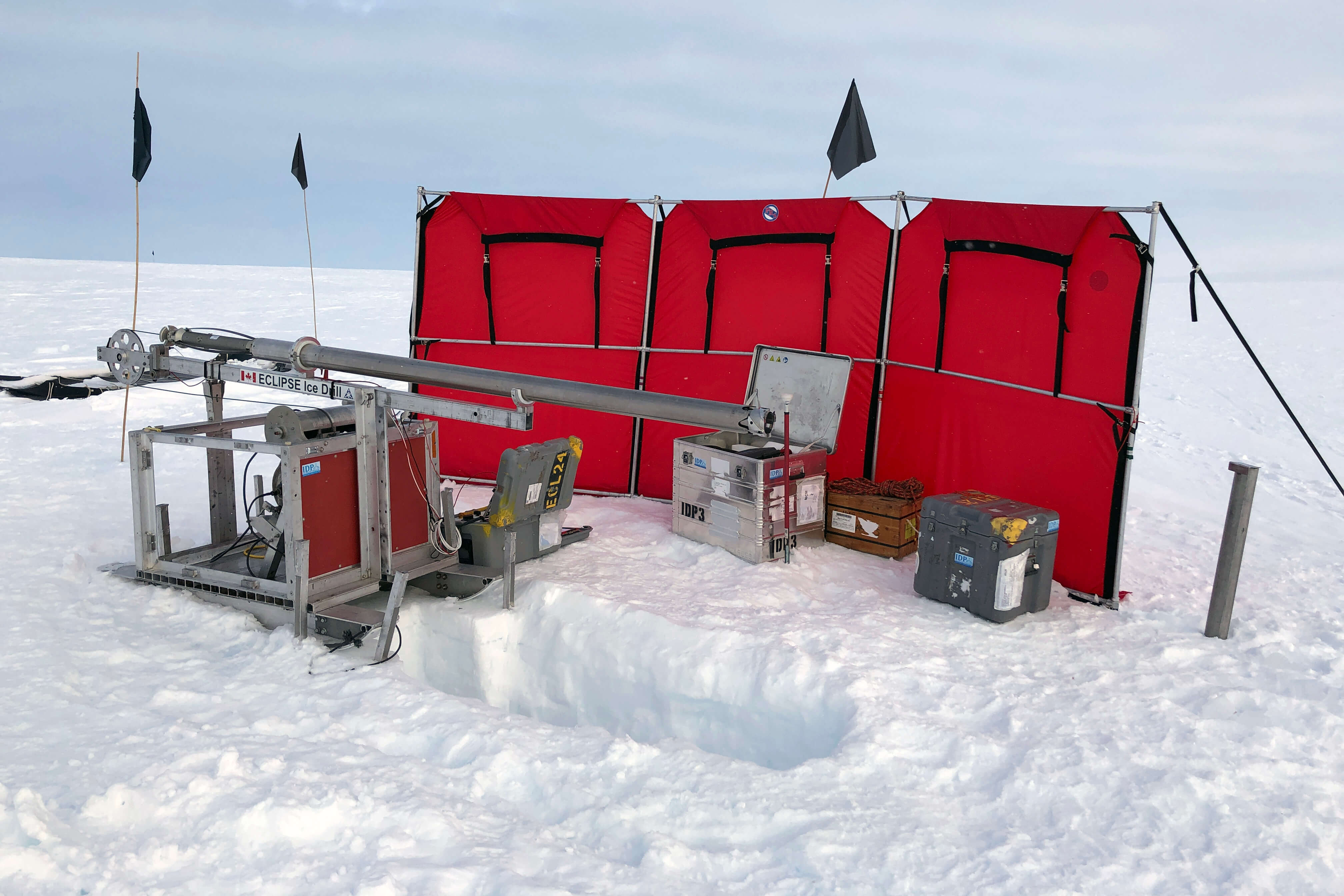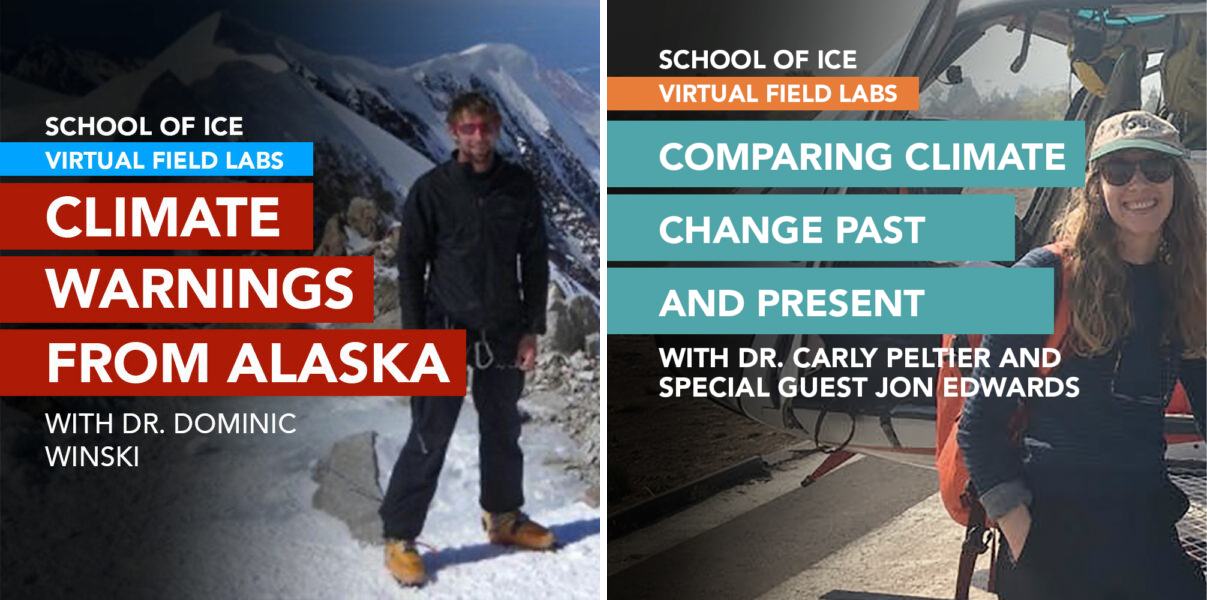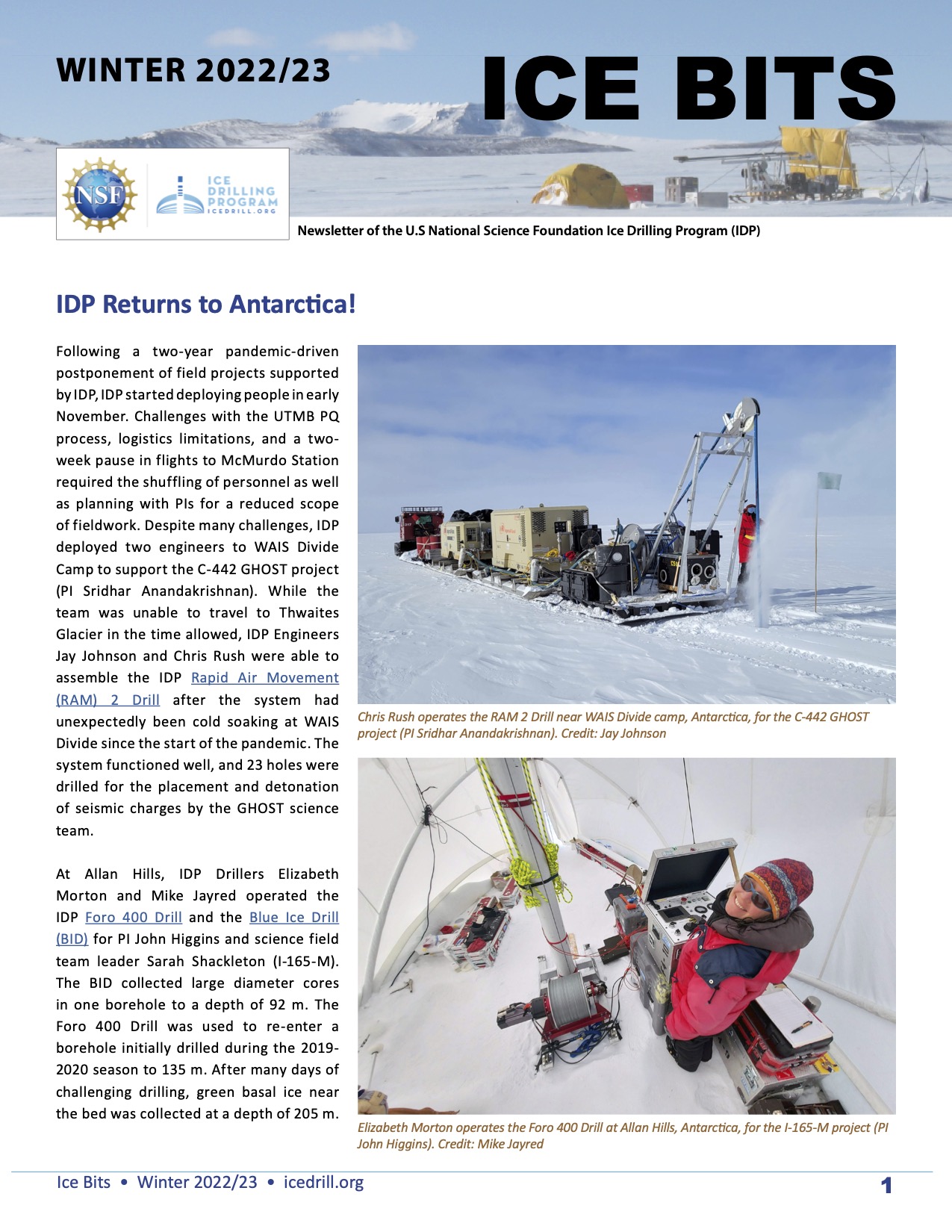IDP Returns to Antarctica!
- Fieldwork
Following a two-year pandemic-driven postponement of field projects supported by IDP, IDP started deploying people in early November. Challenges with the UTMB PQ process, logistics limitations, and a two-week pause in flights to McMurdo Station required the shuffling of personnel as well as planning with PIs for a reduced scope of fieldwork. Despite many challenges, IDP deployed two engineers to WAIS Divide Camp to support the C-442 GHOST project (PI Sridhar Anandakrishnan). While the team was unable to travel to Thwaites Glacier in the time allowed, IDP Engineers Jay Johnson and Chris Rush were able to assemble the IDP Rapid Air Movement (RAM) 2 Drill after the system had unexpectedly been cold soaking at WAIS Divide since the start of the pandemic. The system functioned well, and 23 holes were drilled for the placement and detonation of seismic charges by the GHOST science team.
At Allan Hills, IDP Drillers Elizabeth Morton and Mike Jayred operated the IDP Foro 400 Drill and the Blue Ice Drill (BID) for PI John Higgins and science field team leader Sarah Shackleton (I-165-M). The BID collected large diameter cores in one borehole to a depth of 92 m. The Foro 400 Drill was used to re-enter a borehole initially drilled during the 2019-2020 season to 135 m. After many days of challenging drilling, green basal ice near the bed was collected at a depth of 205 m.
IDP Engineer Elliot Moravec and IDP Driller/University of Maine Research Assistant Professor Dom Winski deployed to the Hudson Mountains of West Antarctica to complete the second season of a two-season field effort initiated prior to the pandemic. The C-443 GHC team (PI Ryan Venturelli) traveled to Antarctica via Punta Arenas, Chile, and Rothera Station in a project jointly supported by the U.S. Antarctic Program and the British Antarctic Survey. Unfortunately, season operations were plagued by flight delays, moisture in the Eclipse Drill motor sections from being unexpectedly cold-soaked in Antarctica for two seasons due to COVID, and encountering surprise crevasses resulting in temporary work stoppages for safety evaluations. The drillers were ultimately able to drill one borehole through clean ice and dirty ice layers, but a thick frozen clay layer near the bottom of the hole prevented the collection of subglacial rock core with the Winkie Drill.
Two New Virtual Field Labs – Climate Warnings from Alaska and Comparing Climate Change Past and Present
- Education/ Outreach
Virtual Field Labs are unique interactive education and outreach products designed for students from late middle school to college. The Virtual Field Labs are designed for students to watch with a teacher present (virtually or in-person) or independently on their computers. Each Virtual Field Lab takes students along with a climate scientist as they collect and analyze data to answer a different climate question.
IDP has two new Virtual Field Labs! The first Virtual Filed Lab, Climate Warnings from Alaska, by Dr. Dom Winksi, explores how snowfall and snow melt events have changed since fossil fuels became the dominant fuel source for humans. The second Virtual Field Lab, Comparing Climate Change Past and Present, by Dr. Carly Peltier and Jon Edwards, explores what climate change was like in the Earth’s past and then compares rates of climate change in the Earth’s past to the changes in climate we are experiencing today.
IDP Letter of Support for Pre-proposal Concept Outlines for USAP Antarctic Fieldwork
- Fieldwork
- Funding Opportunities/ Solicitations
As a reminder, the Antarctic Research Requiring U.S. Antarctic Program (USAP) Support for Fieldwork NSF program solicitation (NSF 23-509) requires the submittal of a Concept Outline describing needed logistical support prior to submission of a full proposal. The Concept Outline allows for a preliminary assessment of the logistics feasibility of the proposed activities and feedback to the PI about potential supportability for proposed activities before the development of a full proposal. The Concept Outline requires the same information as the Logistics Requirement and Field Plan. And for projects requesting services from NSF-supported research support facilities (such as IRIS, UNAVCO, PGC, IDP, NCALM, etc.), a letter from the facility indicating the feasibility and additional costs needed to support the proposed research is a requirement for the Logistics Requirement and Field Plan.
If you are preparing a USAP fieldwork proposal that includes any support from IDP, you should include a Letter of Support from IDP in the Concept Outline. Researchers are asked to provide IDP with a detailed support request three weeks prior to the date the Letter of Support is required. Early submissions are strongly encouraged.
For additional information on requesting IDP support, visit our website at https://icedrill.org/requesting-field-support or contact us at IceDrill@Dartmouth.edu.
IDP Policy for Acknowledgements
- Publications
The U.S. Ice Drilling Program (IDP) is a program funded by the U.S. National Science Foundation (NSF) that conducts ice coring and drilling in some of the world’s most intriguing and challenging environments: the Arctic, Antarctic, and temperate glaciers. The cores and boreholes produced provide important evidence of the past, and the drilling scene is compelling. IDP engineers, drillers, and IDP drilling apparatus in the field need to be acknowledged in photos, social media, and press releases. In addition, IDP must be acknowledged in publication of results of analysis of ice cores, rock cores, and samples that IDP has drilled. Our policy for each is as follows.
Photographs to be made available to the public
Photographs of IDP staff to be used in social media, press releases, or publications must have prior permission from the staff depicted. In addition, if IDP equipment is included in the photo, permission must be acquired from the IDP Director of Operations, Kristina Slawny.
Social media including Twitter, Instagram, Facebook, YouTube
Tweets and social media posts that contain photos or mention of IDP staff and/or IDP drilling equipment should credit IDP by providing the IDP tag. If the post includes a photo of IDP staff, prior permission from the staff depicted is also needed. The content of the post should not imply that the drilling is being conducted by any entity other than IDP.
The IDP tags are:
| @US_IceDrilling | https://twitter.com/US_IceDrilling | |
| us_icedrilling | https://www.instagram.com/us_icedrilling/ | |
| USIceDrillingProgram | https://www.facebook.com/UsIceDrillingProgram | |
| YouTube | @USIceDrillingVideos | https://www.youtube.com/user/USIceDrillingVideos |
Press releases
Articles written by any non-IDP entity intended for press release containing photos or mention of IDP staff and/or IDP drilling equipment need to acknowledge the U.S. Ice Drilling Program. In addition, if the post includes a photo of IDP staff, prior permission from the staff member depicted is also required.
Publications
Papers written for publication in any journal or magazine that contain results from analysis of cores, samples, or boreholes that IDP drilled must contain the following acknowledgment:
“We thank the U.S. Ice Drilling Program for support activities through NSF Cooperative Agreement 1836328.”
Ice Drilling Support for NSF Polar Proposals
- Funding Opportunities/ Solicitations
- Education/ Outreach
If you are preparing a National Science Foundation (NSF) proposal that includes any kind of support from IDP, you must include a Letter of Support from IDP in the proposal. If your fieldwork requires support from the U.S. Antarctic Program (USAP), you should include a Letter of Support from IDP in the pre-proposal Concept Outline (see NSF 23-509 for more details) .
Researchers are asked to provide IDP with a detailed support request three weeks prior to the date the Letter of Support is required. Early submissions are strongly encouraged.
Scientists who seek to include IDP education and outreach activities associated with U.S. ice coring or drilling science projects should contact Louise Huffman at Louise.T.Huffman@Dartmouth.edu during their proposal preparation stage.
For additional information on requesting IDP support, visit our website at https://icedrill.org/requesting-field-support or contact us at IceDrill@Dartmouth.edu.

